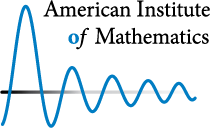2. Complex geometry
-
Problem 2.1.
[Heather Macbeth] Find a toric proof of the toric case of the orbifold compactness theorem proved by Chen-Weber. -
A complex manifold is called almost Kähler if it admits a complex structure $J$, not necessarily integrable, and a Hermitian metric $g$ such that $g(\cdot,J\cdot)$ defines a closed 2-form. One says that $g$ and $J$ are compatible.Solved by Sekigawa for non-negative Einstein constant.
Problem 2.2.
[Casey Kelleher] (Goldberg Conjecture) Is a compact, almost Kähler, Einstein manifold necessarily Kähler? -
It was pointed out by Donaldson that such a solution would prove the uniqueness of cscK metrics
Problem 2.3.
[Gábor Székelyhidi] (Question of Donaldson) Find smooth solutions to the equation \[\ddot{\varphi}- \frac 12 |\nabla \dot \varphi|^2_{\omega_\varphi}=-\lambda R_{\omega_\varphi}\] for $\lambda>0$ on $M \times [0,1]$ with $\varphi|_{M\times\{0\}}=0$, $\varphi|_{M\times\{0\}}=\varphi_0$. -
Problem 2.4.
[Eleonora Di Nezza] $M$ Kähler, $\theta$ big cohomology class. Can we define a family of distances generalizing the Finsler geometry of Kähler potentials and compatible with weak Mabuchi geodesics? -
May try using the counterexample of Ross-Witt Nyström from Hele-Shaw flow to produce such a counterexample.
Problem 2.5.
[Valentino Tosatti] Find a counterexample to the maximal rank conjecture.
Conjecture (Maximal Rank Conjecture)
Let $A\subseteq\mathbb C$ be the annulus $A = \{1<|w| < e | w \in \mathbb C \} $. Given $(M,\omega)$ $n$-dimensional compact Kähler manifold, $\varphi_0$ and $\varphi_1$ potentials, the geodesic on $M \times A$ is obtained as the weak limit of solutions to the family of degenerating complex Monge-Ampère equations \begin{cases} (\pi^*\omega + i \partial \overline \partial \Phi_\delta)^{n+1} = \delta (\pi^*\omega + i dw\wedge d\overline w)^{n+1} \\ \Phi_\delta|_{M\times { 0 } }=\varphi_0 \\ \Phi_\delta|_{M\times { 1 } }=\varphi_1. \end{cases} Then $(\pi^*\omega+i\partial \overline \partial \Phi_\delta)|_{M\times\{\mathrm{pt.}\}} \geq \varepsilon \omega$ for $\varepsilon >0$ independent of $\delta$. -
Solved for $\alpha>1 - \frac 1 n$ by Li-Li-Zheng.
Problem 2.6.
[Eleonora Di Nezza] Let $u$ be a plurisubharmonic function satisfying \[ (i \partial \overline \partial u)^n = \psi \] with $\psi>0$ and smooth. Assume $u$ is $C^{1,\alpha}$ for $\alpha > 1 - \frac 2 n$, then $u\in C^\infty$. -
Let $(M,\chi)$ compact Kähler, and $\omega$ another Kähler metric on $M$. There are necessary and sufficient conditions for solving \[ \mathrm{tr}_{\omega_\varphi} \chi = c \] where $c = n \frac {[\omega]^{n-1} \cap [\chi]} {[\omega]^n}$ is a constant (Song-Weinkove) in terms of a positivity condition. However, this may be hard to check in general.Condition is necessary, by Donaldson. Solved by Collins-Székelyhidi in the toric case.
Problem 2.7.
[Ben Weinkove] (Conjecture of Lejmi-Székelyhidi) There exists a solution if and only if \[ \int_V{(c \omega^p - p\omega^{p-1}\wedge \chi)}>0 \] for all proper subvarieties $V \subset M$, where $p = \mathrm{dim}(V)$ -
Problem 2.8.
[Eleonora Di Nezza] Can one establish regularity properties of geodesics in the space of Kähler potentials for singular Kähler varieties? -
By Colding, $M$ and $M'$ are necessarily diffeomorphic for $\varepsilon>0$ sufficiently small.
Problem 2.9.
[Jiewon Park] Let $(M,\omega)$ and $(M',\omega')$ be compact Kähler-Einstein manifolds which are $\varepsilon$-close in Gromov-Hausdorff distance. Is there a holomorphic family $M_t$ with $M_0 = M$ and $M_1=M'$?
Cite this as: AimPL: Nonlinear PDEs in real and complex geometry, available at http://aimpl.org/nonlinpdegeom.
